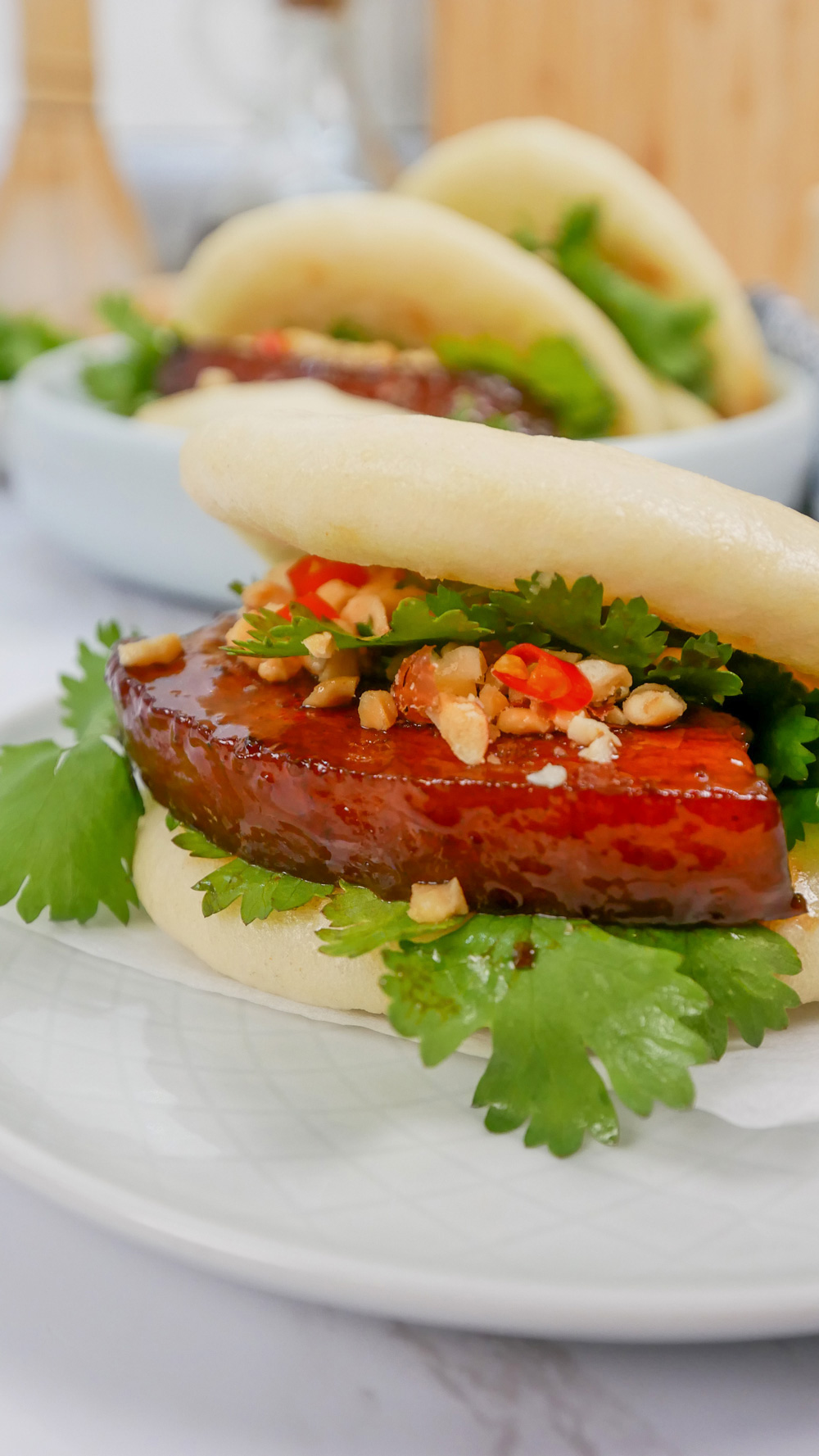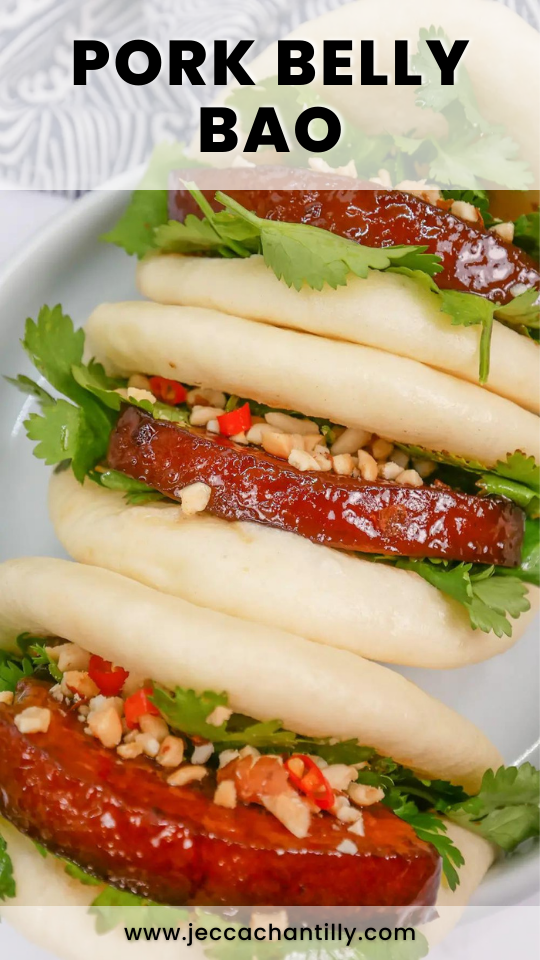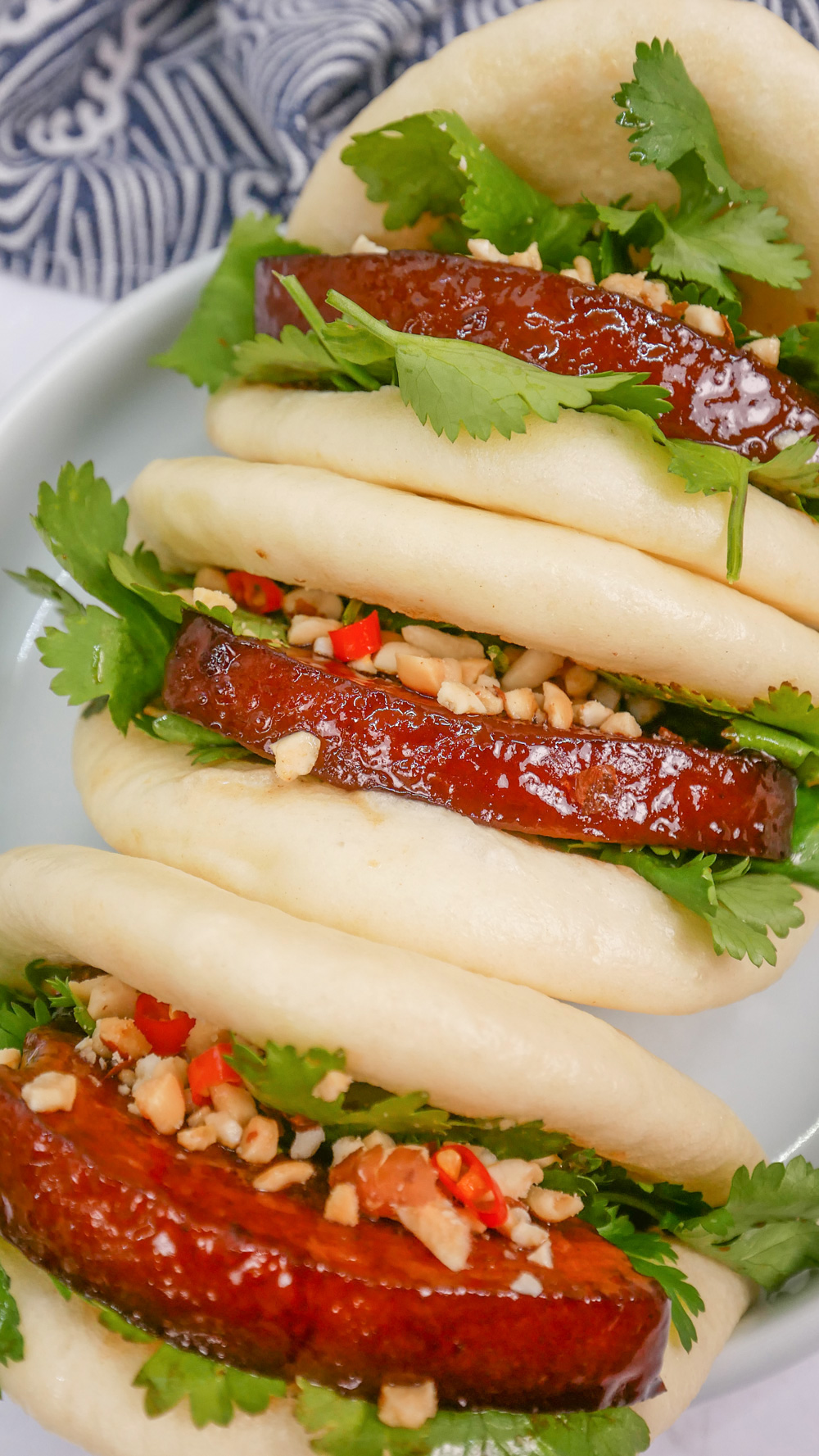I don’t know about you but I am obsessed with Taiwanese pork belly baos or ‘gua bao’ and whenever they’re on the menu, I always have to order them. But with inflation at its peak, I’ve been making a conscious effort to cook more meals at home. I realized that many of my favorite restaurant foods can be made right in the comfort of my home, and even better!
The pork belly is braised in a rich and savory sauce until it’s tender and melts in your mouth. This gua bao is the perfect combination of salty, sweet, and spicy – and I promise you’ll be hooked after just one bite!
Soft and pillowy steamed baos are the foundation of this recipe, and I think it’s worth the extra time and effort to make them from scratch. You can also make them in advance and keep them in the freezer, which is what I usually do. Check out my Steamed Bao Bun recipe in the recipe card below! If you don’t have the time or patience to make homemade bao’s at home, you can find them at your local Asian market.
Get ready to level up your pork belly bao game with this recipe!
Why you’ll love this recipe
This pork bao bun recipe will captivate your taste buds with its delicious blend of textures and flavors. Succulent and tender pork belly is braised to perfection and encased within a soft pillowy bao bun. It’s garnished with fresh cilantro and Thai chili adds a peppery freshness and spiciness that cuts through the richness of the pork belly. While crushed peanuts provide a crunchy touch for extra texture. While these are the more traditional garnishes, pork belly baos are highly customizable with various toppings and sauces so feel free to experiment with flavors and ingredients you like!
Another great thing about these pork bao buns is their compact nature, so you can eat them on the go or bring them to picnics. They’re also the perfect appetizer or can hold their own as a full meal. This recipe serves 3 people, but you can easily double it up, allowing you to share with friends and family!
How do I prepare Pork Belly Bao?
Follow the step-by-step recipe below to prepare this recipe:
Step 1: Cut the pork belly
Cut the pork belly into 1-inch thick and 3-inch long pieces.
Step 2: Pre-heat the oil
Heat oil over medium heat in a large cast iron pot or Dutch oven.
Step 3: Sear the pork belly
Sear the pork belly in a single layer for 1 to 2 minutes on each side. Repeat for all pork belly pieces. Remove from the heat and set them aside.
Step 4: Add the aromatics and seasonings
In the same pot, toss in ginger and garlic, then saute for 1 to 2 minutes until fragrant. Next, add water, rock sugar, star anise, bay leaf, Chinese five spice powder, white pepper powder, Shaoxing wine, soy sauce, and dark soy sauce. Add the pork belly pieces back into the pot.
Step 5: Boil and simmer
Bring the mixture to a boil, then reduce to a low simmer. Cover the pot with a piece of parchment paper and lid. Simmer on low for one hour.
Step 6: Flip the pork belly
After one hour, remove the lid and parchment paper and simmer for another 20 to 30 minutes or until the sauce has thickened into the consistency of warm honey. Flip the pork belly halfway so both sides are evenly coated. Be sure to keep an eye on the pork belly to prevent it from burning.
Step 7: Prepare the steamed baos
Prepare the steamed baos and keep warm until ready to assemble.
Step 8: Assemble the bao buns
To assemble the bao, take a steamed bao and place cilantro on the bottom. Next, layer on a piece of the braised pork belly, a spoonful of braising sauce, more cilantro on top, crushed peanuts, and a few slices of Thai chilis.
Step 9: Serve
Arrange the bao buns on a plate. Serve and enjoy warm!
Cooking Tips for Pork Belly Bao
Here are a few cooking tips you can keep in mind to make the most delicious pork belly bao every time:
- Searing the pork belly on each side helps develop a nice brown crust and deeper flavor. This also helps seal in the juices so they stay succulent after braising.
- Placing parchment paper on the lid prevents it from forming a hard skin and allows the pork to braise evenly.
- Feel free to adjust the amount of Thai chilis to add according to your spice level. You can also omit them if you don’t want your pork bao buns spicy.
Ingredients & Substitutions
Steamed baos: you can make my steamed bao bun recipe in advance or buy pre-made ones at your local Asian market.
Skin-on pork belly: having the skin on the pork belly is essential for making it extra delicious and indulgent.
Oil: you can use any neutral oil you have for searing and sauteing the ingredients, including vegetable, peanut, avocado, sunflower seed, corn, canola, or grapeseed oil.
Garlic cloves: garlic cloves add a distinct garlicky flavor and aroma.
Ginger: ginger adds a refreshing, spicy flavor and aroma to the pork belly.
Rock sugar: rock sugar is used to sweeten the sauce. It’s commonly used in Chinese cuisine however you can use white or brown sugar as a substitute. Just make sure to adjust the amount according to your taste.
Star anise: star anise provides a sweet and licorice-like flavor to the pork belly.
Bay leaf: bay leaf adds a subtle depth of flavor and aroma to the pork belly. It’s essentially a flavor enhancer and quite difficult to substitute.
Chinese five spice powder: Chinese five spice powder adds warm, sweet, and licorice-like flavors that complement well with the star anise. Alternatively, you can create your own blend by grinding and mixing together Chinese cinnamon, cloves, star anise, Sichuan peppercorns, and fennel seeds as a substitute.
White pepper powder: white pepper powder adds hints of floral notes and spice to enhance the overall flavor. You can use black pepper powder as a substitute.
Shaoxing wine: Shaoxing wine adds a sweet, dry, and sharp flavor to the pork bao bun. It’s also used to tenderize the meat and eliminate any unpleasant odors. You can use dry sherry, mirin, or sake as a substitute.
Soy sauce: soy sauce is the main seasoning ingredient and adds a salty and umami flavor to the pork belly.
Dark soy sauce: dark soy sauce is mainly used for color to darken the pork belly. You can substitute this with regular soy sauce.
Water: water is used to dilute the sauce and braise the pork belly.
Fresh cilantro: fresh cilantro adds a freshness and a peppery flavor to the pork bao buns. If you’re not a fan of cilantro, you can substitute it with your favorite herbs including Thai basil and scallions.
Crushed roasted peanuts: crushed roasted peanuts add a nutty flavor and crunchy texture. While peanuts are a traditional ingredient, feel free to use other nuts, like cashews, almonds, or walnuts. Just make sure they’re roasted so the nuttiness is intensified.
Sliced Thai chilis: sliced Thai chilis spice up your pork bao buns. You can also use serrano or jalapeno peppers, or simply omit them!
Frequently Asked Questions
Can I prepare the pork belly in advance?
Yes, absolutely! The pork belly can be braised in advance and reheated once ready to serve. You can even make this a day in advance. Just make sure to steam the baos right before serving so they stay warm and fluffy.
How do you steam the bao buns?
Line the bottom of the steamer with parchment paper to prevent the bao buns from sticking. Then, fill the steamer with water and heat it over medium-high heat. Put the bao buns inside, making sure they’re spaced out. Allow them to steam for 8 to 10 minutes or until they’re puffed up. Turn off the heat and allow the buns to continue steaming for another 5 minutes. Remove the bao buns from the heat, and assemble your pork bao buns.
What should I use if I don’t have a steamer?
If you don’t have a traditional steamer, you can use a metal colander or strainer. Place it over a pot of boiling water, making sure the water doesn’t touch the buns, and cover with a lid.
How can I store pork belly bao buns?
The pork bao buns are best enjoyed fresh. However, if you need to store it, separate the pork belly and baos and store them in airtight containers in the refrigerator for up to 2 days. Reheat the pork belly on the stove or microwave and steam the bao buns until warm, about 10 minutes.
Looking for more easy & delicious pork recipes?
1. Korean Pork Bone Soup (Gamjatang) – if there’s one dish I could eat for the rest of my life, it’d be gamjatang!. It’s a hearty, comforting dish packed with tender fall-off-the-bone meat and vegetables, served in spicy, flavorful soup.
2. Char Siu Noodle Soup – this recipe is a childhood favorite. It’s a comforting dish loaded with tender char siu, vegetables, and noodles surrounded by a flavorful warm soup.
3. Korean Boiled Pork Belly (Bossam) – treat yourself to a plate of bossam. It’s a classic Korean dish made with pork shoulder or belly that’s boiled in various aromatics and seasonings until they’re melt-in-your-mouth tender!
4. Pork Katsudon – for a quick and delicious meal, this 30-minute pork katsudon recipe never fails to hit the spot. The perfectly fried pork cutlet is topped with sweet onions, eggs, and dashi broth – guaranteeing to satisfy your cravings.
5. Char Siu Fried Rice – if you have leftover rice and char siu, combine them into this savory fried rice dish. It’s quick, delicious, and filling, I guarantee you’ll be wanting more!

Pork Belly Bao Recipe (Gua Bao)
Ingredients
- 6-8 steamed baos homemade or store-bought, see note 1
- 1 lb skin-on pork belly
- 1 tbsp oil
- 3 garlic cloves smashed
- 4 slices ginger
- 2 tbsp rock sugar
- 1 star anise
- 1 bay leaf
- 1/2 tsp Chinese five spice powder
- 1/2 tsp white pepper powder
- 3 tbsp Shaoxing wine
- 1 tbsp soy sauce
- 3 tbsp dark soy sauce
- 2 cups water
Garnish
- Fresh cilantro
- Crushed roasted peanuts
- Sliced Thai chilis substitute with jalapeno or serrano pepper
Instructions
- Cut the pork belly into 1-inch thick and 3 inch long pieces.
- In a large cast iron pot or dutch oven, heat oil over medium heat.
- Sear the pork belly in a single layer for 1-2 minutes on each side. Repeat for all pork belly pieces. Remove and set aside.
- In the same pot, toss in ginger and garlic and saute for 1-2 minutes until fragrant. To the pot, add water, rock sugar, star anise, bay leaf, Chinese five spice powder, white pepper powder, Shaoxing wine, soy sauce, and dark soy sauce. Add the pork belly pieces back into the pot.
- Bring to a boil then reduce to a low simmer. Cover the pot with a piece of parchment paper and lid. Simmer on low for one hour.
- After one hour, remove the lid and parchment paper and simmer for another 20-30 minutes or until the sauce has thickened into the consistency of warm honey. Flip the pork belly half way so both sides are evenly coated. Be sure to keep an eye on the pork belly to prevent it from burning.
- Prepare the steamed baos and set aside until ready to assemble.
- To assemble the bao, take a steamed bao and place cilantro on the bottom. Next, layer on a piece of the braised pork belly, a spoonful of braising sauce, more cilantro on top, crushed peanauts and a few slices of Thai chilis.
Notes
- Check out my homemade Perfectly Steamed Bao Bun recipe
Pin & save this recipe for later!


I bought pork belly for the first time and was so excited when I found this recipe. it was easy to follow and delicious. even both my kids were huge fans.
Hi Kristine! I’m so happy that they turned out delicious 🙂